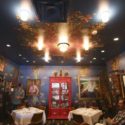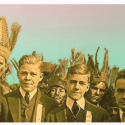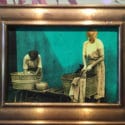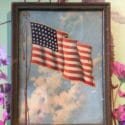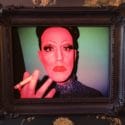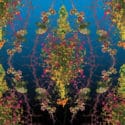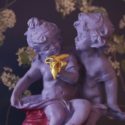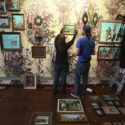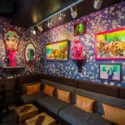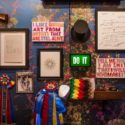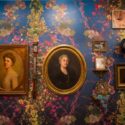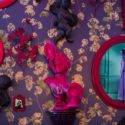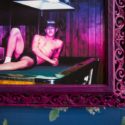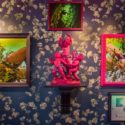Practices of Everyday Life
Fallen Fruit’s new Site-specific installation for 21c at Proof On Main on view through 2018.
David Burns and Austin Young/Fallen Fruit, (American)
The Practices of Everyday Life, 2016
Mixed media, including wallpaper, painting, prints, and found objects
“Fallen Fruit’s immersion into the people and places that have shaped this community reveals a multitude of stories and connections in a visually dazzling and profoundly genuine expression of place making,” said Alice Gray Stites, 21c Museum’s ground-breaking director and chief curator. “21c is proud to have commissioned an ambitious project that is truly locally engaged and globally connected. The installation addresses a universal aspect of the human condition, hunger-to be fed, to be seen, to belong, to be loved. The persistence of these desires fosters the continuity of ritual: the practices of everyday life don’t really change-we eat, drink, we talk, we congregate and celebrate in ways that would be recognizable to our forbears at least a century ago-these acts retain meaning and promise.”
David Burns and Austin Young, who work as the duo Fallen Fruit, explore and transform located geographies and narrative histories at the intersections of public and private spaces. This site-specific commission is inspired by a wide range of definitions of “the public,” from the stranger or passerby to the vast public spaces of the Internet, and includes collective histories found in native and creationist mythologies, generational knowledge, and public and private archives.
“We created a work of art in the form of an art installation at Proof on Main that celebrates people and place using source material from architectural salvage yards, historical images, personal diaries, amateur films, and ephemera from Louisville, Kentucky and Southern Indiana,” explain the artists. Constructed from dozens of individual photographs, texts, and objects, their research-based work is intended to celebrate the culture of place. The selection of each photograph, wall treatment, or object is deliberate; even the seemingly obtuse or misplaced is carefully chosen to create contrast and to explore conflicting shifts in meaning. The artwork intimately explores the boundary of what is “public” and what is “private.”
At 21c, Fallen Fruit’s custom wallpaper patterns represent the spectrum of historical, environmental, and cultural characteristics of Louisville, Kentucky. The wallpaper in Proof lounge features photographs of the pear tree blossoms that line sidewalks downtown and other parts of the city. The experience of love blooms, wanes, returns, and revives in the sculptures, photographs, and other objects that constitute It Happens To Everyone Some Day / The Last “Gay” Bar In America. Images of notable citizens like Henrietta Bingham, David Williams, Stephen Irwin, and others hang beside contemporary pin ups, evoking endless tales of passion, romance, heartbreak, and inspiration.
The red dogwood blooms seen in the main dining room’s wallpaper pattern reference a Cherokee creationist myth, while the framed artworks hanging here represent the pre-contact culture of this region prior to 18th century European settlement. Kentucky once served as a hunting ground for native cultures. Later trading posts drew in both settlers and natives. The bison and landscape photographs were taken by the artists at Goshen County’s Woodland Farm in 2016. Taxidermy bison busts hang near the restaurant windows; their majestic features are mirrored in the pop-art portraits hanging amid photographs of forests and rivers, Native Americans, as well as historical documents, and other ephemera. The images of Native Americans come from the archives of the Library of Congress, and include 20th-century portraits for which sitters were sometimes costumed, posed, and paid to represent cultures that were already doomed by European-American expansion.
In the west dining room, Farm To Table / 1864 to 2016 honors Kentucky’s agrarian roots, which have sustained this community for over two centuries: the space is wallpapered with images of vegetables and fruits grown at Woodland Farm, some of which are served in the restaurant. Images of some of the complex histories about Kentucky evoke contemporary issues that persist in the United States today, including our relationship to food production, systemic poverty, and urban development. And in the private dining room, Love Is All You Need pays homage to 21c founders Laura Lee Brown and Steve Wilson: the paintings and objects on view here are drawn from their personal collections, while the wallpaper features patterns of the flowers grown in the gardens of their home in Oldham County.
“The practices of everyday life,” explain the artists, are “everyday interactions by everyday people that create community and generate the stories that become history and mythology. It is the both the extraordinary and the overlooked that together simultaneously make a place special and unique. There are moments in life that we share communally, often regionally, and sometimes generationally, that are meant to be celebrated, shared, and remembered. These moments may be discovered in the mundane, or hidden away in archives for future generations. We are interested in the idea of the public, citizenship, and community, and how everyday people are poets and scribes and artists and documentarians as much as they are strangers, neighbors, and friends. As artists, we realize that it is not one particular story that tells the truth about a place. Instead we believe that community is formed by many different people’s stories and collectively these stories about place and people form the cultural bonds we celebrate and honor through local traditions and more.”
Founded in 1778, and named after King Louis XVI of France, Louisville has negotiated boundaries and bridged shifts between “here and there” from the beginning. . Defined by the Ohio River on the north and the west, it was once frontierland at the edge of the United States; until 1816 it functioned as a gateway to the West. The area served as a boundary between the North and the South during the Civil War. Enslaved African Americans escaped to freedom here, where the Underground Railroad crossed the river. The word “Kentucky” translates from native languages as “the blood of the land”) but it also can mean the “place of tomorrow.” It was the beginning and end of the explorations of Lewis and Clark. In the 20th century the federal government twice obstructed river access, first by installing massive flood control walls following the great flood of 1937, and later in the 1960’s by building interstate highways that block the city’s relationship to its waterfront.
While the artists found diversity and difference in the city, they say, “We learned that one thing Louisvillians have in common is that they are neither Southern nor Northern, not from the West coast or the East coast; they are kind, welcoming people from an important region of Kentucky that has a long history in the United States, and a pride in heritage and love of family that is both steadfast and true.” Young and Burns note that Louisville is home to several expansive historical archives that contain vast collections of photography, film, personal effects, legal documents, and ephemera. They add, “These types of archives exist in most major cities in the United States, however the depth and breadth of the archives at the Carnegie Center for Art and History, the Indiana Room at the New Albany Public Library, the University of Louisville, and the Filson Historical Society are models for the entire country .”
“The archival materials for the installation project activate selected images that explore meanings of everyday life through the lenses of other people’s cameras,” observe the artists. “We use language and phrases excerpted from the page’s other peoples’ notebooks and diaries-although the display of the artwork renders authorship of the material anonymous. After all, our collaboration is with people who we cannot ever really know.”
Some of the images the artists installed may seem cliché or banal, while others offer challenges. . The content selected spans several generations, from the mid-1800s to the present day. By their nature archives often contain things that were once private; personal meanings from other peoples’ lives get replaced over time, becoming signifiers that represent a broader understanding. Often the subjects of the stories that have been isolated and removed from context in hard to find file boxes become transformed in a new context that speaks to and reflects contemporary experiences.
“We believe that contemporary art has the ability to shift vision, alter meaning and explore humanity,” say Burns and Young, “In these ways both abstraction and collage may appear beautiful to a stranger or passerby, and at the same time could also inspire an in-depth discovery of the sundry and nuanced complexities embedded in these images, objects, and documents from other people’s lives. The element of chance is an important part of any discovery. It is the unexpected message you may come across in daily life that redirects your attention, or that important ,’glimpse in a mirror’ that creates a short pause, or an unexpected rainbow you see on a landscape that makes you smile regardless of age. This opportunity to allow the unexpected into our lives may change a perception of space and an experience of time even for a short moment. Like a breath or a pause in movement, a flicker in an old film, a pop on an old recording, these glitches are a form of magic that reminds us that life is really happening in the moment and we are all in the process of living it with everyone around us. In these ways both the extraordinary and banal become temporarily equal and these forms of collective experience become integrated with our own individual authorship of life-in a very basic way we have no other choice.”
“We are interested in the idea of the public, citizenship, and community, and how everyday people are poets and scribes and artists and documentarians as much as they are strangers, neighbors, and friends,” say the artists.
Exhibited Works
Installations:
It Happens To Everyone Some Day / The Last “Gay” Bar In America, found frames, found photography from the archives of Emily Bingham, David Williams, John Lair, Bill Carner, Letitia Quesenbarry and the archives at the University of Louisville, original pin-up photography, found objects, custom soundtrack and video playlist on Youtube, 2016
Kentucky / , found frames, found taxidermy busts, original photography from Goshen, Kentucky, found photography from the Edward Curtis collection at The Library of Congress, 2016
Farm To Table / 1864 – 2016, found frames, found objects, found photography, 2016
All You Need Is Love, found objects from personal collections and archives of Laura Lee Brown and Steve Wilson, 2016
Sculpture:
Bizarre Love Triangle, found objects, epoxy acrylic paint, 2016
The Golden Pussy, found object, gold leaf gilding, 2016
It Feels Like The First Time, found object, epoxy, acrylic paint, 2016
#PARTY, found object, epoxy, acrylic paint, 2016
The Innocents, found object, found locket necklaces, portraits of the senior class from a 1964 yearbook, epoxy, acrylic paint, 2016
Acknowledgments:
Fallen Fruit and 21c Museum Hotel are deeply grateful to the Carnegie Center for Art and History, New Albany, the Indiana Room at the New Albany Public Library, the University of Louisville, and the Filson Historical Society for granting the artists access to their archives. We also wish to acknowledge the generosity of the Indiana Room and the Carnegie Center for providing many of the images and documents featured in The Practices of Everyday Life. Additional materials were made available by the Library of Congress, and by individual members of this community, including Laura Lee Brown and Steve Wilson, Emily Bingham, David Williams, and others.
ABOUT 21c MUSEUM HOTEL
A multi-venue museum, 21c was founded by Laura Lee Brown and Steve Wilson, contemporary art collectors and preservationists who are committed to bringing works of art to the public through innovative exhibitions and programs that integrate contemporary art into daily life. 21c Museum presents a range of arts programming curated by Museum Director, Chief Curator Alice Gray Stites, including thought-provoking solo and group exhibitions that reflect the global nature of art today, as well as site-specific, commissioned installations, and a variety of cultural events. The organization collaborates on arts initiatives with artists and organizations worldwide, including North Carolina Museum of Art, MASS MoCA, Contemporary Art Museum Houston, The Barnes Foundation, Contemporary Arts Center, Cincinnati, Creative Capital Foundation, and others. Since opening in Louisville, KY in 2006, 21c Museum has presented more than 85 exhibitions, including Cuba Now!;?Alter Ego: A Decade of Work by Anthony Goicolea; Blue: Matter, Mood, and Melancholy; Aftermath: Witnessing War, Countenancing Compassion; Hybridity: The New Frontier; Seeing Now; Dis-semblance: Projecting and Perceiving Identity; Albano Afonso: Self-Portrait as Light; and Pop Stars! Popular Culture and Contemporary Art

